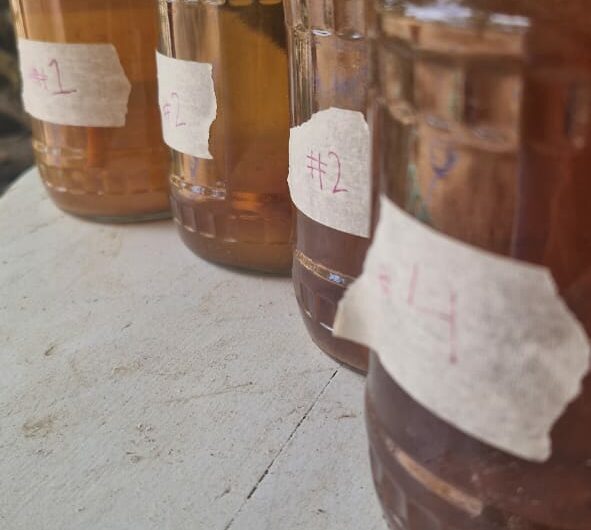Dio Pigadia’s kombucha
Born in China over 2000 years ago and brought to the western world in the 18th century, kombucha is a “miracle drink” that enhances your health, beauty and brainpower. With kombucha’s low sugar content, when it undergoes a process of prolonged fermentation, it produces organic acids like glucuronic acid & gluconic acid.
Note: multiply the recipe depending on the amount of water your jars can hold
Ingredients
1/3 cup granulated sugar
4g of black/green tea (not perfumed) or 2 tablespoons loose tea leaves
At least 1 cup of kombucha from previous batch (neutral mix)
SCOBY (symbiotic culture of bacterias and yeast)
Directions
- FOR THE FIRST FERMENTATION
- Infuse the tea with hot water for 15 minutes.
- Remove the tea and add the sugar in the warm water, stir to dissolve it.
- Add the kombucha from the previous batch, the SCOBY and fill up with filtered water.
- Cover with a clean dish towel and secure with a rubber band or a length of string.
- Set the jar or jars somewhere dark and cool, and allow to ferment 8 to 14 days, tasting occasionally after 1 week. Aim for a light fermentation and a slightly vinegary taste.
- FOR THE SECOND FERMENTATION
- Remove the SCOBY and around 3 cups of kombucha (I often keep the bottom liquid to have the more sediments of the SCOBY).
- Add any flavor to your different bottles: pineapple, raspberry, tamarindo, jamaica tea, lemon, ginger, rosemary, thyme, honey or any other tea or herbs. The new flavors should represent 10% of the total quantity of kombucha. If the flavors you are adding do not contain natural sugars (honey or fruit juice) it is best to add some sugar (unless it is still very sweet) to help add some carbonation. Pour it through a funnel into air tight bottles. Try to leave only a little air in the top to help aid carbonation.
- Let sit somewhere dark and cool for 3 to 7 days, checking after 3 to taste how bubbly the kombucha has become, then place in the refrigerator until ready to drink, to stall the fermentation. Serve cold.
Notes
- If the green or black tea leaves have some perfume, it contains an oil that kills the good bacterias of the SCOBY. Make sure to use normal black or green tea. Black tea is more efficient.
- Always use really clean bottles, container and tools. Use glass container and not plastic. Use filtered water or let sit few minutes the tap water before mixing it. Again, bad bacterias can infiltrate and good bacterias be killed.
- The time of fermentation is approximate, taste often since the 5th day to see if the acidity of the fermentation suits you (and to see if it is effective). It should be a lighter orange when it is ready.
- The SCOBY will be moldy if it’s sick; it will be like mold on a bread (blue, white, little dots), then you need to throw everything out.
- There is 2 fermentations for having a nice fizzy kombucha but also, you need bottles with anti-pressure caps. They will seal and then provide bubbles, but if you use another kind of hermetic lid, it can overload the pressure and explode.
- The larger the SCOBY, the faster the fermentation will be, and so filled with probiotics and the taste will be acidic. The more the kombucha jars are in a hot and sunny place, the faster the fermentation also will be. It is not more or less convenient, it depends on your needs.


